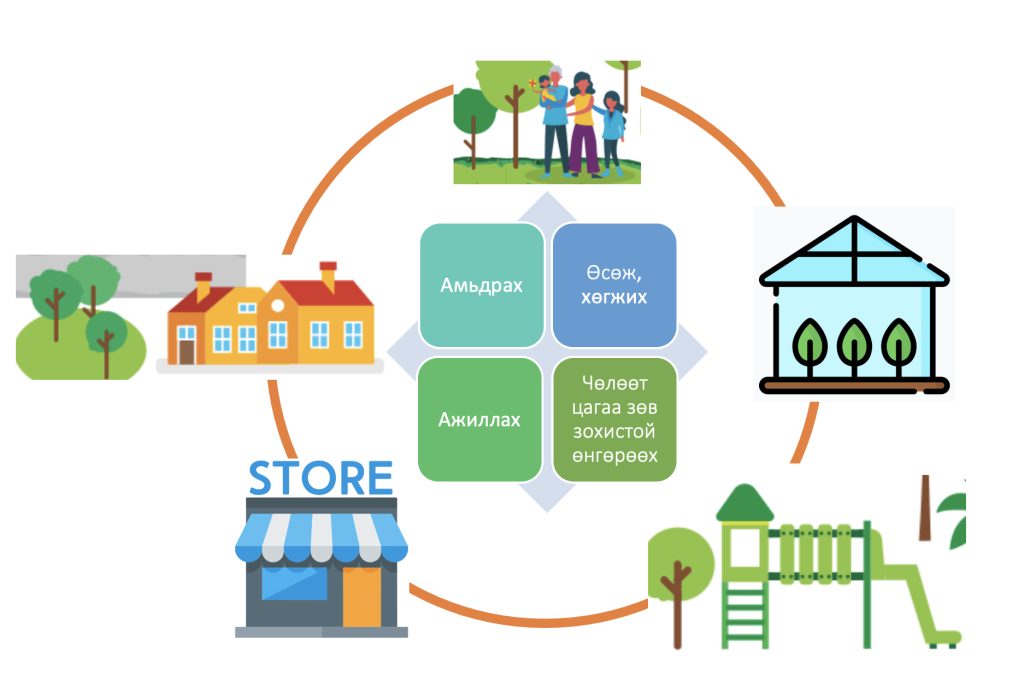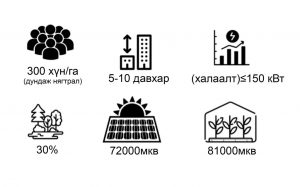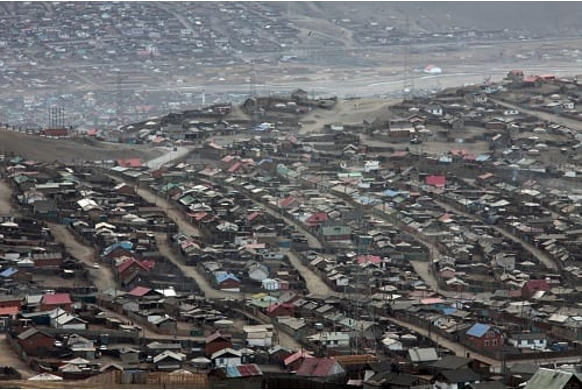







To transform Ulaanbaatar into a city that offers excellent living and working environment for its citizens, our focus is to address the needs of residents within the residential areas and create a well-rounded community with social, economic, recreational, and green spaces, as well as ample housing opportunities.
"Eco-District: Principles of Inclusive Integrated Planning"

The principles underpinning Eco-District planning revolve around a people-centric approach, integrated planning, universal access, energy efficiency, and presence of ample green spaces.

Eco-District is a result of a planning approach that is based on the engagement of diverse groups of population, including the elderly, people with disability while ensuring equal gender representation to create a liveable neighborhood with accessible services, and efficient commuting. The guiding principle of this planning approach includes the following elements:
The green elements of Eco-District require the use of environmentally friendly recyclable building materials that are locally sourced and produced with heat and water efficient technology , and that meets hygiene and energy efficiency requirements while promoting a healthy lifestyle.
Housing units
The proposed housing units enable social mixity targeting diverse income people:
There are approximately 12 types of apartments available here, ranging in size from 35m² to 80m². Among them, two types of housing specifically designed for individuals with disabilities comprise 10% of the total offerings.
Income-adjusted housing implies that the cost of accommodation does not surpass the financial capacity of the household. Internationally, affordable housing is determined by ensuring that housing costs do not exceed 30 percent of the monthly income of the target community. However, it's crucial to recognize that affordability is relative; what is affordable for high-income households may not be feasible for low-income ones. Thus, it's essential to develop housing options tailored to the income and genuine needs of the target group.
In Mongolia, the strategy for affordable housing was formulated by experts in the sector through the "Ulaanbaatar City’s Affordable Housing Strategy" document in 2014. The primary strategic directions outlined to facilitate the provision of affordable housing for target households include:
A green housing encompasses features such as reduced heat and energy consumption, lower greenhouse gas emissions, water conservation measures, and a 20 percent decrease in overall building energy consumption.

internationally, there are numerous exemplary models of green affordable housing. One such notable example is Morrisania Homes in the Bronx, New York, USA, constructed in 2007. Recognized as one of the pioneering green and affordable housing developments, Morrisania Homes offers a mixed-use environment catering to low-income and middle-income residents.
In alignment with global best practices, the "Ulaanbaatar green affordable housing and resilient urban renewal project" is a vital initiative designed to address the long-term financial stability of its target population. This project is characterized by its energy efficiency, incorporation of advanced engineering solutions, and creation of a conducive living environment for citizens. Notably, it is resilient to the impacts of climate change and minimizes waste generation.
Climate change
The Affordable Housing and Resilient Urban Renewal Project (AHURP) will launch a large-scale demonstration initiative, providing comprehensive, integrated, and affordable solutions for ger area households and leveraging private sector investments. The aim of the project is to deliver 10,000 green housing units that are energy efficient, affordable, and designed to maximize the use of renewable energy. 100 hectares of ger areas will be redeveloped into eco-districts that are both low-carbon and climate resilient as part of the project.
The objectives of the project, based on a range of climate adaptation and mitigation measures, are to (i) improve the climate resilience of Ulaanbaatar city and the adaptability of Mongolia to climate change; and (ii) reduce greenhouse gas emission and pollution, and improve the livability in Ulaanbaatar city, by transforming the highly climate-vulnerable and high polluting peri-urban areas of Ulaanbaatar (ger areas) into eco-districts characterized as low-carbon, climate resilient, and affordable.
Greenhouse gas emission

Ger areas are settlements of low- and middle-income households characterized by loosely aligned plots, creating irregular pathways that remain unpaved.
People living in the ger areas of Ulaanbaatar are highly vulnerable to climate change, and air pollution, caused by households burning coal for heating and cooking, contributing in turn to greenhouse gas emissions.
The Project addresses these concerns by providing the population in selected ger areas a low-carbon and climate resilient alternative via affordable housing in apartments that are connected to the main urban infrastructure service networks.
The resulting impact will be improved living conditions in Mongolia by assisting Ulaanbaatar to be a safe, healthy and green city that is resilient to climate change and provides a livable environment for its residents. For example, a reduction in air pollution in ger areas will also benefit 1.4 million residents of Ulaanbaatar.
The resulting impact will be improved living conditions in Mongolia by assisting Ulaanbaatar to be a safe, healthy and green city that is resilient to climate change and provides a livable environment for its residents. For example, a reduction in air pollution in ger areas will also benefit 1.4 million residents of Ulaanbaatar.
AHURP aims to achieve energy efficiency higher than present Mongolian Standards require and reduce dependence on CO2 producing energy sources. As Mongolia is moving towards integrating modern energy efficiency technology into prevailing standards for design, construction and operation of buildings, and utilities services, the project will enable and contribute for the implementation of energy efficiency in housing sector.
Annual greenhouse gas emission reductions due to AHURP are preliminarily estimated at 204,410 tCO2e, as the result of investments in solar PV (17,261 tCO2e/y) and insulation of buildings (187,149tCO2e/y).
Project benefits and beneficiaries
Mitigation
Adaptation
Mitigation measures:
Energy efficiency/Additional insulation: Energy consumption for heating from 395 kWh/m2 per year to 151 kWh/m2 per year; 74 sqm additional insulation per apartment
Solar PV: 11MW, 72,000 sqm PV solar panels on rooftops
Street-lighting: Energy efficient street-lights for eco-districts
SMART monitoring system: Heating regulation system, energy efficiency monitoring system, renewable energy control, sensors for building control, air filter, etc.
Green areas: 30% of land use is public space including 15% of green space and green areas at each eco-district
Adaptation measures:
Greenhouse: Eco-district will have greenhouses for operation by the residents to support livelihood and food supply.
The number of beneficiaries including direct replication is at least another 35,000 people and including indirect replication is projected to be 350,000 people. The above estimate excludes the inhabitants of the apartments that will be built after the end of AHURP using the funding mechanisms developed during AHURP.
The total number of primary direct beneficiaries enjoying enhanced resilience to climate change will be at least 35,000, which corresponds to the expected number of inhabitants of the new apartments built within AHURP. The new apartments will provide better protection against harsh Mongolian winters and the consequences of climate change through better flood protection, providing access to water and sanitation, and improved waste and wastewater management.
At least 18 percent of the footprint of the buildings and facilities of the project will be covered with solar panels. Totally 72 000 m2 of solar panels will be installed within the whole project.
The rooftop solar PV system is planned to be a grid-connected battery less system.
In the event that solar energy cannot meet the electricity consumption of households in the eco-district on weekends and other times of high consumption, it will supply electricity from the central distribution network and work together with solar PV.

In the event that solar energy cannot meet the electricity consumption of households in the eco-district on weekends and other times of high consumption, it will supply electricity from the central distribution network and work together with solar PV.

On cloudy days and after sunset, households will be supplied with electricity from the distribution network.
